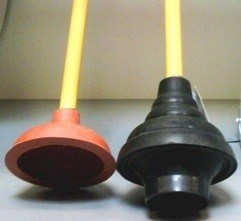One of the most functional plumbing tools is the plunger. A plunger is used to dislodge clogs in drainage and sewer pipes. It features a very simple construction design consisting of a rubber suction cup and a plastic or wood handle or shaft. The plunger does many amazing things in the kitchen and bathroom and that is why it has earned such affectionate names like the plumber’s helper and the plumber’s friend. The plunger is used to unclog all types of drains including the kitchen sink drains, the shower drains, and more frequently the toilet drains. Plungers are very easy to use. You just hold the handle and insert the rubber end in the clogged sink or toilet drain. Ensure that you form a tight seal with the clogged drain because the plunger works on the principle of a vacuum. You should then apply pressure to “suck” and dislodge the clog from the drain. It’s quite easy in practice. You do not need a professional plumber to unclog your toilet with a plunger.
Consider The Type
The first thing that you need to know about plungers is that they come in two main types and they are both designed for different uses. These two different types of plungers feature different functional designs. A plunger will help you save money on DC sewer services when your drains are clogged. But you must first choose the right plunger for the job. Here is how to do it. Let us look at the two main types of plungers.
Flat-Bottomed Plunger
The classic flat-bottomed plunger is designed for unclogging kitchen sink drains and shower drains. This plunger features a rubber ending that looks like a rubber ball cut in half. This enables the plunger to seal tightly on the flat surface on the sink drain or shower drain. Make sure that you choose this type of plunger for your kitchen sinks drains and shower drains.
Flange Plunger
The flange plunger is specifically designed for unclogging toilets. This is the most widely used plunger because toilets get clogged more frequently. In addition to the typical half rubber ball at the end of the shaft, the flange plunger also features another extra bit protruding from the rubber end. This extra bit helps create a tight seal in the curved toilet drain.
Consider Drain Sealing
In order for the plunger to dislodge the clog, it must form a tight seal with the clogged drain pipe and create a vacuum. You should always ensure that you buy a plunger that seals tightly with the toilet, sink or shower drain. You can test the plunger in your local hardware store before purchase. You will note that old worn-out plungers are quite ineffective because they have holes and cracks that allow air to seep through.
Consider The Handle
Plungers come with either a wooden or plastic handle. You should ensure that the plunger’s handle or shaft offers an excellent grip to avoid discomfort while unclogging your drains. Some plungers need a little elbow grease on the handle to work. Choose a high quality plunger with a firm grip and a long-lasting handle to make work easier.




